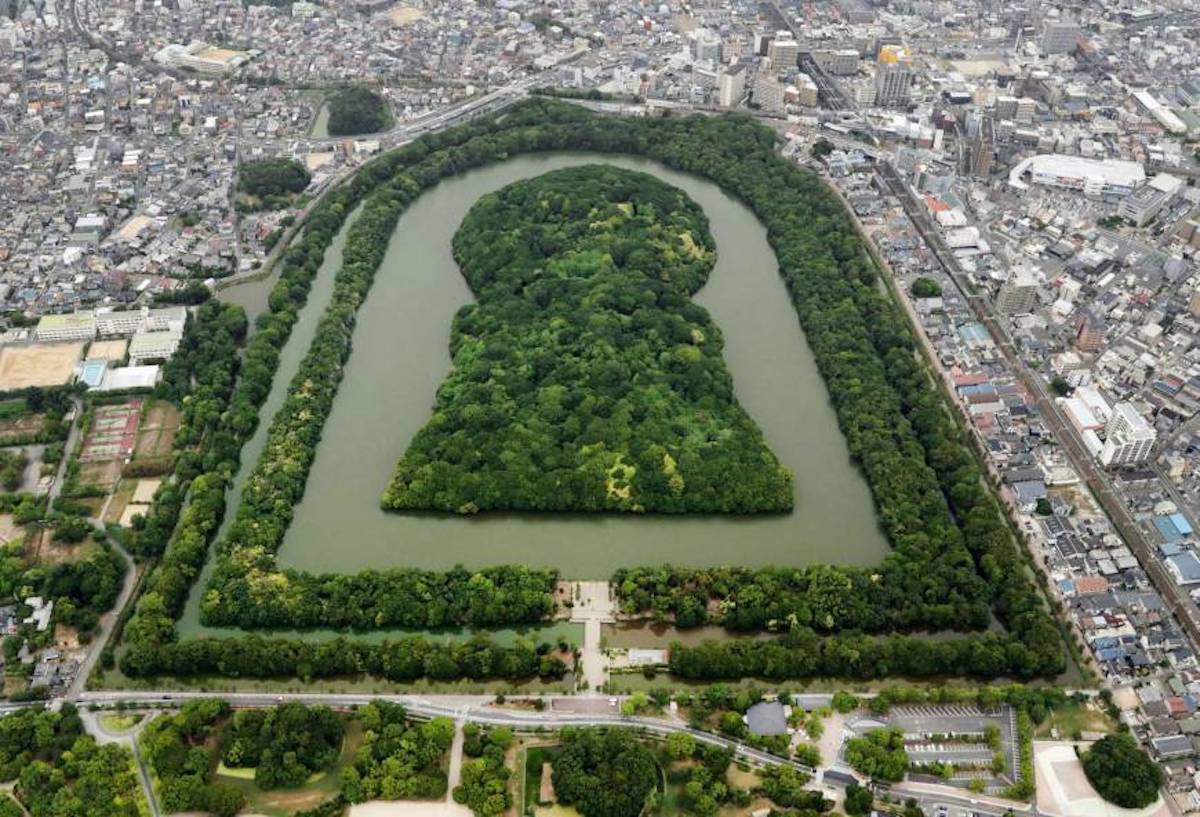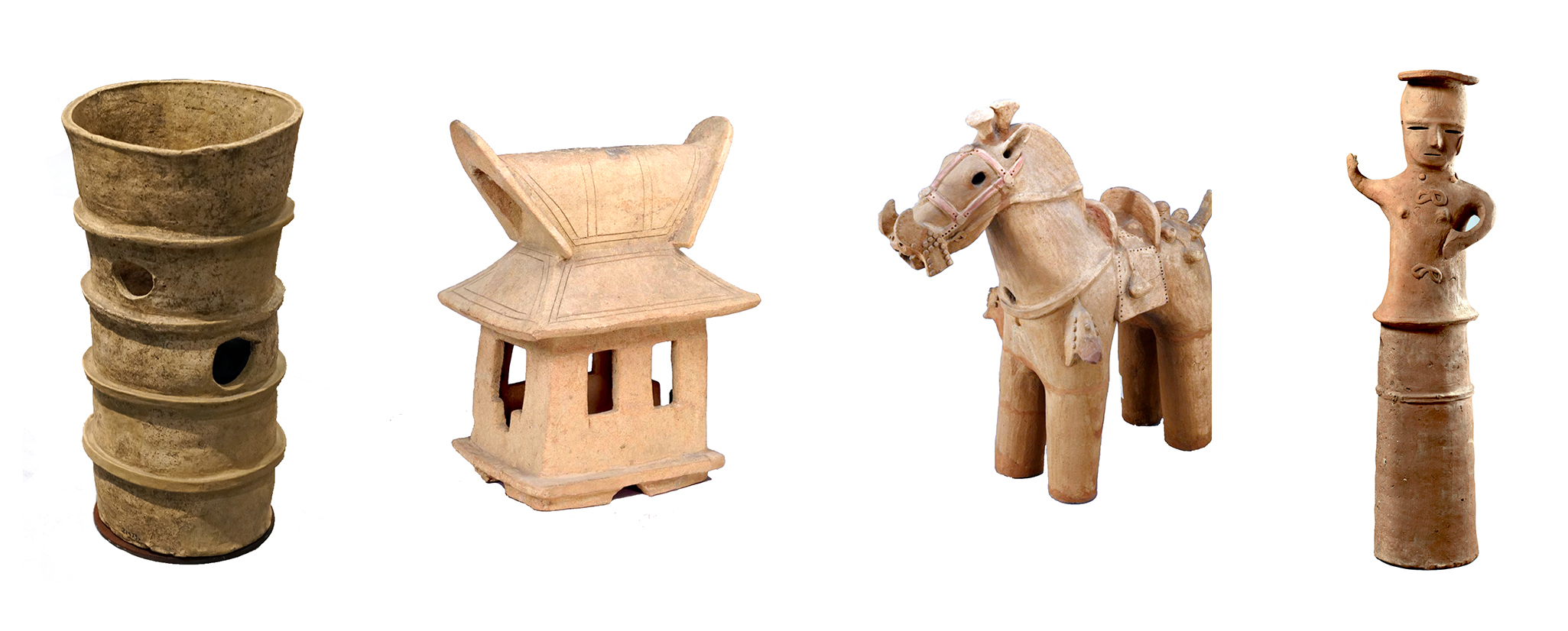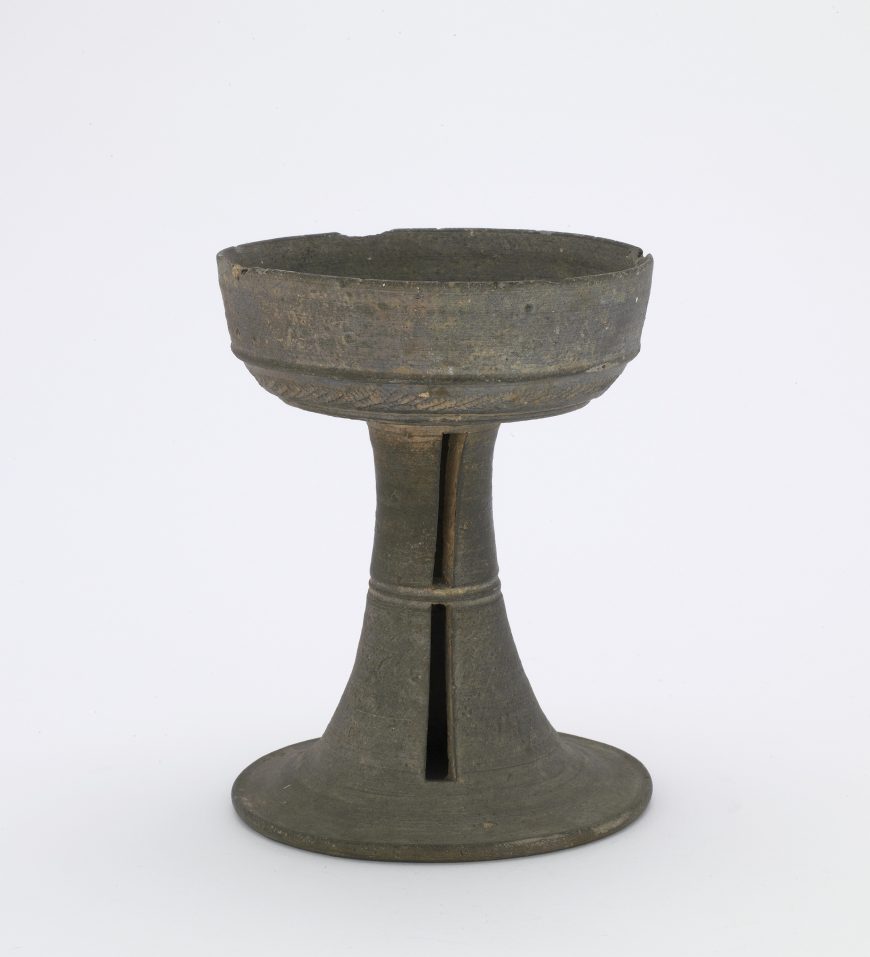
The Nintoku mausoleum in Sakai, Osaka prefecture, Japan, part of the Mozu-Furuichi group of ancient burial sites known as kofun (image: KYODO, Japan Times)
Kofun period (c. 3rd century–538 C.E.): influential importations from the Asian continent
The Kofun 古墳 period in Japan is so named after the burial mounds of the ruling class. The practice of building tomb mounds of monumental proportions and burying treasures with the deceased arrived from the Asian continent during the 3rd century. Originally unadorned, these tombs became increasingly ornate; by the 6th century, burial chambers had painted decorations. The burial mounds were encircled with stones; hollow clay earthenware, known in Japanese as haniwa 埴輪, were scattered for protection on the land surrounding the mounds. Kofun were typically keyhole-shaped, had several tiers, and were surrounded by moats. The resulting structure amounted to an impressive display of power, advertising the control of the ruling families. The largest kofun is the Nintoku mausoleum, measuring 486 meters!

Haniwa. Left to right: Cylindrical haniwa, 5th century, excavated in Kaga-shi, Ishikawa, earthenware (Tokyo National Museum, image: Steven Zucker); haniwa house, 5th century, excavated in Sakura-shi, Nara, earthenware (Tokyo National Museum); haniwa horse, 5th-6th century, Japan, earthenware, partially restored, H. 94 cm (Tokyo National Museum); haniwa of a female shrine attendant, 6th-7th century, Japan, earthenware, 88.9 cm high (Yale University Art Gallery)
The hollow clay objects, haniwa, that were scattered around burial mounds in the Kofun period, have a fascinating history in their own right. Initially simple cylinders, haniwa became representational over the centuries, first modeled as houses and animals and ultimately as human figures, typically warriors. The later pieces have been of great help to anthropologists and historians as tokens of the material culture of the Kofun period, offering a glimpse into that society. Whether offerings for the dead or protective barriers meant to guard the tombs, haniwa have a strong aesthetic identity that continues to be a source of inspiration for Japanese ceramists.

Shallow cup on tall pedestal foot, Kofun period, 6th century, Japan, Sue ware, unglazed stoneware, H. 15.1 cm (Gift of Charles Lang Freer, F1907.525, Freer Gallery of Art)
Through gradual consolidation of political power, the Kofun-period Yamato clan became a kingdom with seemingly remarkable control over the population. In the 5th century, its center moved to the historical Kawachi and Izumi provinces (on the territory of present-day Osaka prefecture). It is there that the largest of the kofun burial mounds testify to a thriving Yamato society, one that was increasingly more secular and military.
Simultaneously, the potter’s wheel was used for the first time in Japan, likely transmitted from Korea, where it had been adopted from China. This new technology was used to produce what is known as Sue ware—typically bluish-gray or charcoal-white footed jars and pitchers that had been fired in sloped-tunnel, single-chamber kilns (anagama 穴窯) at temperatures exceeding 1,000 degrees celsius. Like other types of ancient Japanese pottery, Sue ware continues to be a source of inspiration for ceramists, in Japan and beyond.
Additional resources:
For information on other periods in the arts of Japan, see the longer introductory essays here:
A brief history of the arts of Japan: the Jomon to Heian periods
A brief history of the arts of Japan: the Kamakura to Azuchi-Momoyama periods
A brief history of the arts of Japan: the Edo period
A brief history of the arts of Japan: the Meiji to Reiwa periods
JAANUS, an online dictionary of terms of Japanese arts and architecture
e-Museum, database of artifacts designated in Japan as national treasures and important cultural properties
On Japan in the Metropolitan Museum of Art’s Heilbrunn Timeline of Art History
Richard Bowring, Peter Kornicki, The Cambridge Encyclopedia of Japan (New York: Cambridge University Press, 1993)
Cite this page as: Dr. Sonia Coman, “Kofun period, an introduction,” in Smarthistory, January 20, 2021, accessed May 14, 2024, https://smarthistory.org/kofun-period/.
Funerary objects meant to be seen

Haniwa: Tomb Sculpture of a Seated Warrior, Japan, late Tumulus period, c. 500-600 C.E., coil-built eathenware with applied decoration, 31 x 14 3/8 x 15 inches / 78.7 x 36.5 x 38.1 cm (Los Angeles County Museum of Art)
Haniwa (“clay cylinder” or “circle of clay” in Japanese) are large hollow, earthenware funerary objects found in Japan. Massive quantities of haniwa—many nearly life sized—were carefully placed on top of colossal, mounded tombs, known as kofun (“old tomb” in Japanese). During the Kofun Period (c. 250 to c. 600 C.E.), haniwa evolved in many ways—their shape, the way they were placed on the mounded tombs and, presumably, their specific function or ritual use.
We don’t know much about haniwa or the Kofun Period because there was no writing system in Japan at the time. However, there is general agreement that haniwa were meant to be seen. That is, instead of being buried deep underground with the deceased, haniwa occupied and marked the open surfaces of the colossal tombs. However, it is unlikely that they were readily visible to any person who happened to pass by since the tombs were sacred, ritualized spaces that were usually surrounded by one or more moats. As a result, close visual contact with haniwa would not have been easy for unauthorized visitors. So who was the intended audience of haniwa? Let’s explore further.
Monumental tombs and early Japan
Unlike many other ancient civilizations, we cannot rely on written records to inform us about the names or locations of the earliest kingdoms in Japan. Yet study of kofun indicate that a powerful state had emerged by around 250 C.E. This state is identified by various names (such as the Yamato polity), and was generally centered in what is now Nara, Kyoto, and Osaka prefectures.
We know that a powerful state emerged since vast resources were needed to construct these monumental tombs—starting with the economic means to sacrifice valuable flat land that could otherwise be used for farming and growing rice. Hundreds of workers were also necessary, and archaeologists excavating kofun have recovered pottery from neighboring locations such as present day Nagoya—suggesting that people came from elsewhere to Yamato to serve the needs of this early state.
Many monumental tombs (kofun) were constructed in the shape of a keyhole—otherwise known as zenpō kōen fun (“front squared, rear rounded tomb”). The square part is the front end while the round section is the rear and contains the body (eventually bodies) of the deceased. Keyhole-shaped tombs were adopted as a kind of signature style of this state. Keep in mind that the tombs could have been made in any particular shape—perhaps an octagon—but it was this keyhole shape that was appropriated and then replicated in other regions. Clearly, a formidable political center had emerged with the ability both to build their own colossal tombs and to extend their funerary practices to distant regions. In other words, the gradual adoption of keyhole-shaped colossal tombs over a wide range attests to the existence of a large, organized state with the authority to compel other, competing kingdoms to adopt their practices, likely through the formation of alliances or perhaps by military coercion.
Most of the earliest surviving keyhole-shaped colossal tombs dating to the 3rd century are found in Nara prefecture. One of these is the famous Hashihaka kofun in Sakurai city—measuring about 280 meters in length and 30 meters in height (image above). As a point of comparison, the pyramid of Khufu in Giza measures about 230m in length and 146m in height.
Three periods in tomb-building practices
Scholars identify three major chronological periods or shifts in kofun-building practices, changes that might correlate to changes in the political climate. Not only did the physical shape and size of the tombs transform, so did the type of haniwa, sarcophagi, and other features used in conjunction with the tombs.
- Early Kofun period: c. 250 C.E. – c. 400 C.E.
- Middle Kofun period: c. 400 – c. 500 C.E.
- Late Kofun period: c. 500 – c. 600 C.E.
The colossal tombs reach a maximum size during the Middle Kofun period, and a well-known example is the Daisenryō kofun (also referred to as the Emperor Nintoku tomb) in Sakai city, Osaka prefecture (image, left).
This is the largest, extant kofun and one of the world’s largest funerary monuments, measuring roughly 486m in length, 36m in height, and may have had 15,000 haniwa placed on top.
This trend towards building kofun that were increasingly larger seems to reflect the increasingly powerful rulers of this kingdom; however, by the Late Kofun period the size of the tombs begin to shrink in size. This may have resulted from the unsustainable practice of using up valuable farming land for tombs. Another factor may have been the arrival of new immigrant groups, primarily via the Korean peninsula, who could effectively challenge the authority and dominance of the Yamato monarchs.
By 600 C.E. or so, mounded tombs were no longer made in the keyhole shape, were considerably smaller, and often took a rounded form. Manufacture of haniwa also ended when keyhole-shaped kofun ceased to be built.
Evolution and placement of haniwa
When kofun were newly completed, the surfaces of the mounds were bare of vegetation—the forests that now cover these tombs are the natural consequence of centuries of neglect. Instead, gravel (or other hard stones), or haniwa, were elaborately arranged on the surfaces. Each haniwa was hand-created.
The earliest haniwa, from c. 250 C.E. to around the 450s, were simple forms and most were cylindrical. There were also haniwa whose upper section was not cylindrical but made to replicate shapes based on ritual or military objects.
While the arrangement of haniwa varied from one tomb to another, consecutive haniwa were often lined up along the outermost perimeter of the tomb surface, as if to mark boundaries. In addition to this chain of haniwa on the outer perimeter, inner sections located near the center of the tomb have also been outlined by haniwa as if to designate a special or main staging area.

Haniwa Horse, c. 300–645, red earthenware, 14 7/8 inches (The Museum of Fine Arts, Houston)
Haniwa in the form of animals, people and buildings

House-shaped Haniwa, 6th century, clay (Museum of the Sakitama Ancient Burial Mounds)
A major shift occurred around 450 C.E., corresponding to the time when kofun reached their maximum size. The upper section of the haniwa were modeled after animals and people (such as female ritual specialists and male warriors). The reason behind this innovation is not known, but presumably reflects changes in funerary practice.
Archaeologists have also unearthed haniwa in the form of ritual specialists and warriors standing in parade-like fashion in front of the houses, as if to stand guard and conduct special ceremonies for the benefit of the deceased.
What role did haniwa play?

Haniwa, standing female, 6th–7th century, reddish earthenware, 88.9 x 26.7 x 20.3 cm / 35 x 10 1/2 x 8 inches (Yale University Art Gallery) “The round clay pieces attached to her neckline appear to be the remnant of a necklace, which suggests she could represent a miko, a maiden serving in Shinto rituals.” (source)
This now leads us to the question of function and intended audience. What role did haniwa play? Who or what was the intended audience? No one knows for sure, but a number of theories have been proposed. It is also important to remember that function and meaning changed over time and place. The most common understanding is that haniwa were initially used to define the perimeter of the sacred tomb, separating and magically protecting the deceased from the profane space of the living.
With the development of haniwa modeled after humans, the ritual specialists were probably arranged on the tomb to re-enact funerary ceremonies seeking to protect the deceased from harm in the supernatural world, while warriors likely stood guard against enemies—whether human or not. In this sense, haniwa may have been intended to be seen by the un-living, perhaps demons or vengeful ghosts. At the same time, some scholars believe haniwa were also intended to be seen by the living (even if only a highly selective few). The range and kinds of haniwa representing aspects from the life of the deceased may have served to indicate the high status and wealth of the tomb’s occupants. Inclusion of animal-shaped haniwa could be explained as an attempt to replicate a kind of exotic zoo or pleasure garden stocked with animals acquired by the deceased, but this is highly speculative.
Style
As for stylistic aspects, the anthropomorphic (human-shaped) haniwa have a distinct appearance, consisting of a small head and blank, minimalist face with cutout openings for eyes and almost no attempt to portray a body with any degree of realism. Yet, oddly, there is a tremendous amount of detail on accessories and wardrobe, often appearing as lifelike replicas of actual weaponry, metal ornaments, and clothing. This somewhat bizarre contrast between the general and the specific is puzzling. One theory suggests that faces and heads were kept small and plain to keep each haniwa as light as possible on top, preventing the clay figure from toppling over. The large holes that perforate various sections may have had a similar function, to reduce overall weight and to facilitate uniform drying of the wet clay as a way to prevent cracks. In this sense, although physical, bodily attributes could be compromised, the correct tools and wardrobe that both identify and empower individuals to fulfill their job requirements were of utmost importance.
Among the haniwa, it could be said that the most precise, careful attention to detail was reserved for warriors and their horses, reminding us of the critical role played by the military during the Kofun period—a time of massive armed conflict. We now turn to the only haniwa that has received designation as a National Treasure in Japan—the Haniwa Warrior from Gunma prefecture currently housed at Tokyo National Museum.
Closeup of the Warrior Haniwa

Haniwa Armored Man, National treasure, excavated in Iizuka-machi, Ota City, Gunma Prefecture, Kofun period/6th century 130.5 cm (Tokyo National Museum) zoomable image ©National Institutes for Cultural Heritage
This national treasure (TNM J-36697) is one of several haniwa unearthed from the vicinity of Ōta city in Gunma prefecture, which tells us that this was an advanced, regional center for haniwa manufacture (Gunma is located to the north of Tokyo, quite far from Nara). This haniwa offers viewers a rare opportunity to see the detailed armor and weaponry (sword, bow, and quiver) of an ancient clay warrior from this region during the late Kofun period.
Starting with the visorless helmet, especially fascinating is the series of small, evenly spaced half-spherical rivets that appear on a raised section on top of the helmet, in addition to raised strips that connect the sides and front to a narrow band that circles around the forehead and continues behind the head. These rivets are believed to represent metal rivets, suggesting that the warrior’s head was protected by a metal helmet. Attached to the helmet are thick protective ear flaps, seemingly made of padded fabric or leather, while a sheet of thinner material wraps around the rest of the head and neck. Rivets also appear on the narrow quiver, containing four or more arrows, strapped to the warrior’s back.
The short-sleeved body armor that flares outward near the hips does not have rivets, but is covered by thin, vertically incised markings. Two large looped ties found on the chest suggest that this armor was laced together; whether the armor was made by stringing together thin iron plates is unclear based on the visual evidence, but remains as a possibility.
On both forearms, the clay warrior wears padded, protective guards. A wide, sheathed sword falls diagonally across the front of the body, apparently hanging from the waist: the warrior has his right hand on the hilt, ready to the draw the sword at a moment’s notice. The fingers of the left hand gently clasp a thin, vertical object that seems to be a bow; fastened just above the wrist on this hand is a thick, sausage-like object that may be a device to protect his hand from the bowstring.
Standing upright with a mask-like, emotionless face (two narrow slits for eyes, an even more narrow slit for the mouth, and a protruding nose), you might not feel immediately threatened by this warrior. Yet, after observing how this haniwa warrior is, in fact, extremely well-armed with his formidable armor, a weapon in each hand, and supply of arrows on his back—clearly prepared to quickly strike down any enemy that comes his way—you might become a bit more apprehensive.
The intended function of this particular haniwa is not ambiguous, but the question of whether all haniwa—both figurative and non-figurative—were believed to protect the tomb’s occupants in similar fashion is one that is difficult to answer, inviting us to keep pondering the secrets that were buried both inside and outside kofun in ancient Japan.















